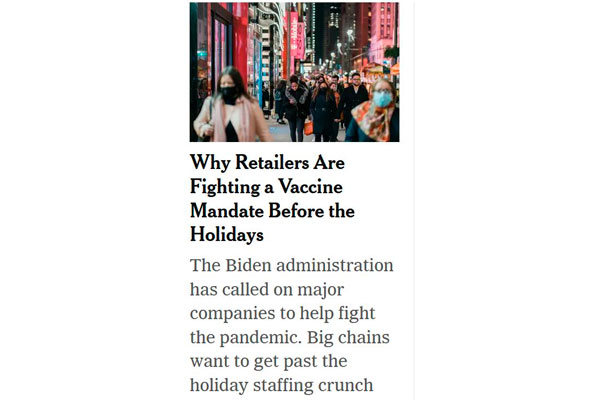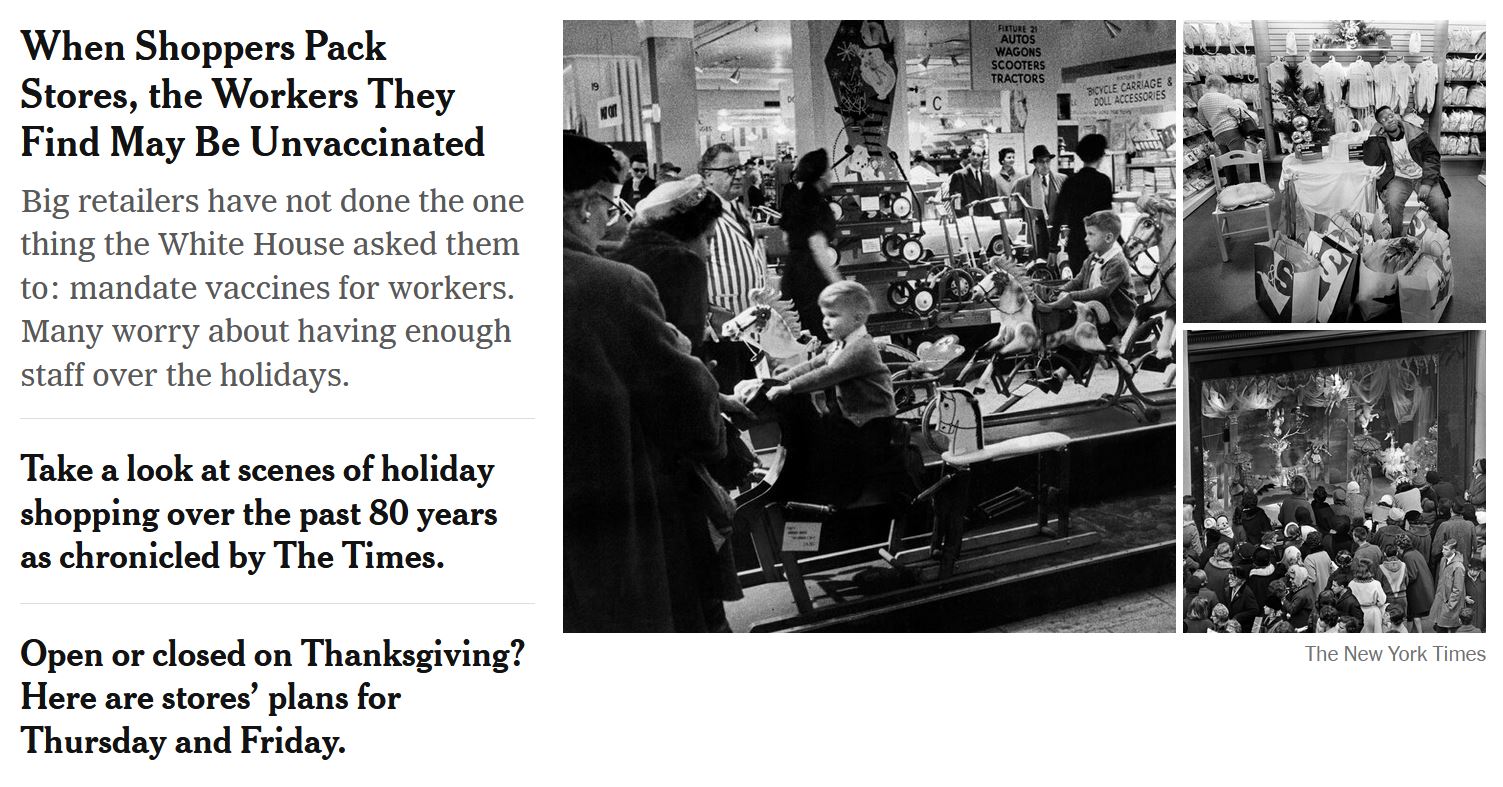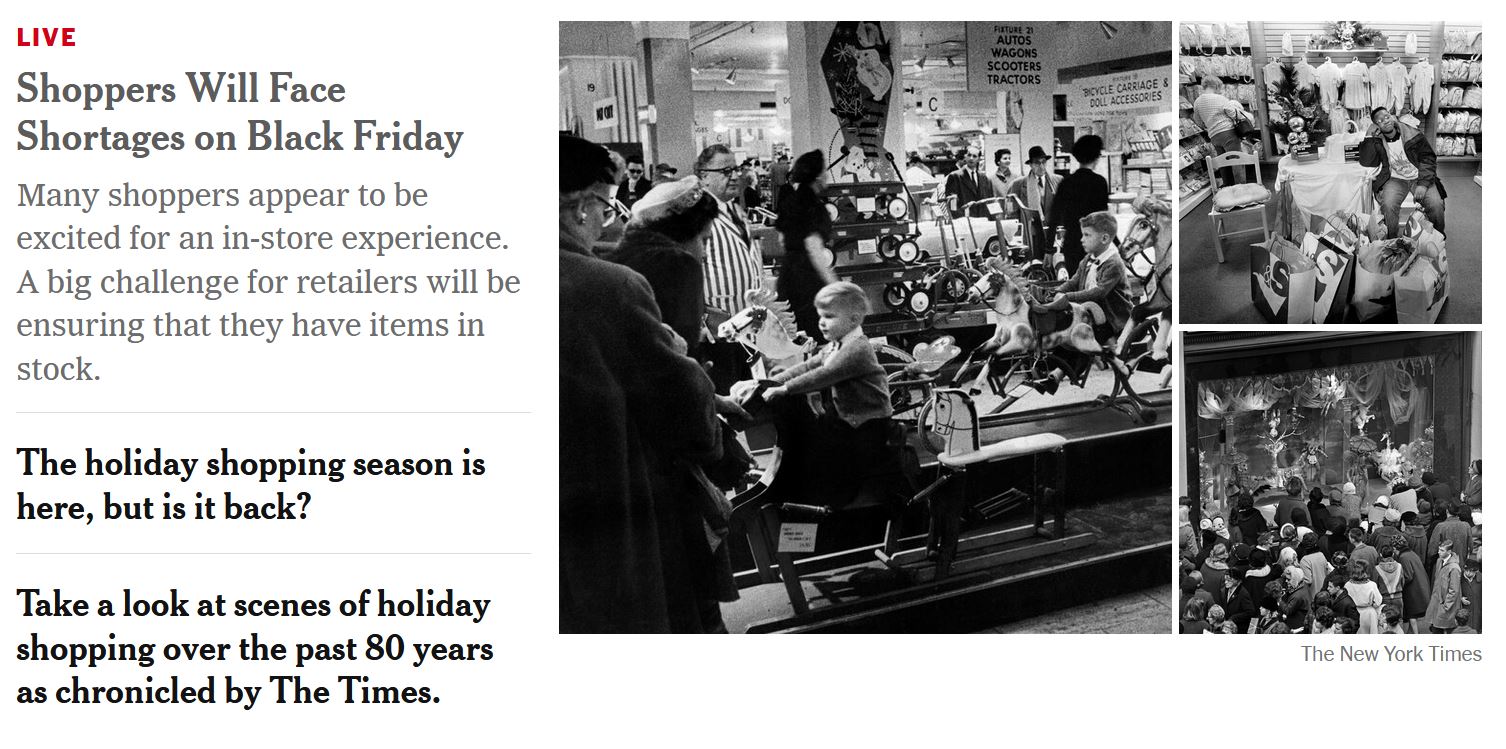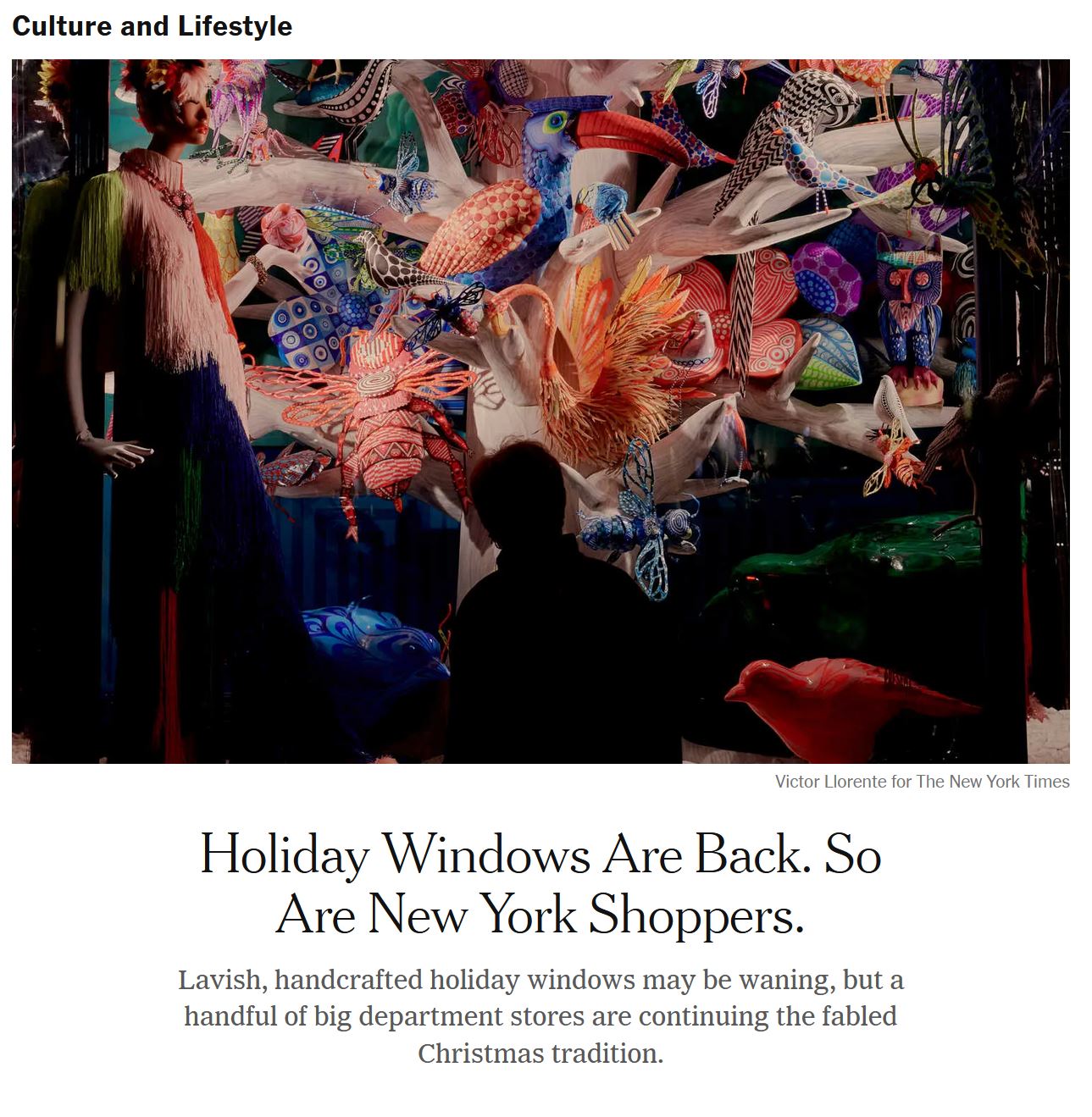A recent headline in the New York Times initially warning shoppers about the risks from unvaccinated workers was subsequently changed and articles extolling shopping on Black Friday were added to the front page.xxxxxxxxxxxxxxxxxxxxxxxxxxxxxxxxxxxxxxxxxxxxxxxxxxxxxxxxxxxxxxxxxxxxxxxxxxxxxxxxxxxxxxxxxxxxxxxxxxxxxxxxxxxxxxxxxxxxxxxxxxxxxxxxxxxxxxxxxxxxxxxxxxxxxxxxxxxxxxxxxxxxxxxxxxxxxxxxxxxxxxxxxxxxxxxxxxxxxxxxxxxxxxxxxxxxxxxxxxxxxxxxxxxxxxxxxxxxxxxxxxxxxxxxxxxxxxxxxxxxxxxxxxxxxxxxxxxxxxxxxxxxxxxxxxxxxxxxxxxx
At the top of the front page on Thanksgiving in the Times was the headline above, “When Shoppers pack stores, the workers they find may be unvaccinated”. The following day, the headline, on Black Friday read: “Shoppers Will Face Shortages on Black Friday”, with the byline “Many shoppers appear excited for an in-store experience”.
Firstly, there are the usual issues with the calculated choice of language one always will find in an article in the Times. One “may” find unvaccinated shoppers, its unsure could be maybe not be, its just tautological innuendo masquerading as parsed legalese that can only ever be true because it accounts for all contingencies. Or that shoppers “appear” excited: is this a commentary looking down out of the window from the editorial building or is it actually based on any evidence produced through a journalistic process, one will never know.
Other articles also appeared on the front page arguing a different perspective on shopping with respect to COVID than the original story. The initial byline was a critique of retailers inadequate efforts to fulfill Biden's vaccine mandate. The updated front-page with the new headline contained the following additional article:
With these changes, the paper is giving space to the arguments of the retailers against the mandates, saying “big retailers want to get past the Holiday crunch first”. The paper clearly has made an about-face with respect to all-out COVID fear-mongering in the face of the possibility of yet-another holiday of lost sales and shop closures, the hollowing-out of all the boutique shops Times writers no doubt depend upon. Yet the fact of a COVID argument that persists in a more narrow, delayed form calls into question the Times integrity with regard to their other COVID reporting. What is the point of forcing compliance on retailers' workers after the busy holiday season is already over? If the point of the mandate is to save lives, as its argued, what's the point of doing it after its most necessary?
We already know that vaccines do not stop transmission of the virus1. Vaccination reduces only fractionally transmission in the first three months after innoculation, but after that, and with the delta variant particularly, there is no difference in viral load and transmission between the vaccinated and unvaccinated, according to the research we have now. The vaccines' effectiveness also wanes2. This is contrary to the moral argument that was made to compel the current high levels of vaccination, which was that it would prevent transmission and thus prevent younger people from infecting older, more vulnerable people.
This fact alone recasts almost all of the reporting currently being done on the pandemic at the Times, as well as what comes from out public health officials who all remain myopically committed to nothing more than vaccinating every living thing in the country: man, woman, child, and now babbies, 'toddlers', and pets. A loaf of bread in every home, or a bowl of rice in every house has now become, explicitly, a shot in every arm. For if the vaccine doesn't prevent transmission, then certainly it makes no sense to fear the unvaccinated workers the vaxxed 'may' encounter in shopping malls and stores. While the bleeding edge of the moral argument around vaccination has become again (as it was at the beginning of the pandemic) about vaccinating to reduce the threat of serious illness and hospitalization, such arguments do not yet explicitly form the basis for the vaccination arguments still being advanced in the Times, or anywhere else in the mainstream media.
On the one hand, this looks like an argument that just doesn't seem to want to die. From the very beginning of the pandemic the trifecta we currently still endure became common-sense and, apparently, peer-review research-supported: lockdowns and travel restrictions, masking, and vaccination. Nothing else, and certainly no forms of treatment have ever been suggested. If anything, there is a hysteria around even the idea that one can treat COVID in any way (e.g., the ivermectin horse-paste scandal). As a result, people really do believe that there are no effective treatments against the virus, despite that this is no longer the case (particularly with pharmaceutical companies preparing for this eventuality, with drugs like Merk's molnupiravir amd Pfizer's Paxlovid), and hasn't been for a long time2. One could be generous to the ignorant journalists at the Times and say that because they don't know about treatment options or of the current science around transmission by the vaccinated the only thing a moral person can actually do is the profoundly philosophical provisional: we do what we can with what we know to the best of our ability.
The alternative (and accurate) assessment of what's going on is that COVID has become about forcing compliance on a citizenry that is on the verge of spinning out of Liberal control. Already before the pandemic, there was Brexit and the emergence of right-wing 'extremism' in response to decades of economic liberalization. In the United States there was the outright rejection of a continuation of the liberal status quo after the rigged primary against Bernie Sanders left Americans with the choice between Hillary Clinton and Donald Trump. Trump was elected as a last-ditch effort to throw a wrench into the workings of this broken, corrupt system that had been selling-out workers for decades. With the emergence of COVID, the liberal constellation of governments and corporations has had the perfect storm through which they can try to redeem their entire political and economic project.
And things could actually have gone that way if they had proceeded according to the ideological terms clearly present at the outset of the pandemic. If vaccines had been provided free to all on a voluntary basis, had been well-tested and their risks and benefits clearly stated, with proper compensation for mandated lockdowns and the loss of business and jobs, there would be no basis for the rancor we're now seeing. Instead, we have lockdowns with no compensation, the loss of jobs, shuttered businesses, the consolidation of economic monopoly and the acceleration of the online marketplace over and against the brick and mortar local.
What we have now is a response to the possibility that post-pandemic any vestiges of the reactionary forces opposing the liberal establishment order might persist. The moment is apparently now to produce the govern-mentality of the citizenry that will provide the foundation for the stability of the perpetuation of the current system for future generations. Seemingly, large segments of the population that seem to have already forgotten about 9/11 and all the invasive surveillance technology and practices (e.g., taking off shoes at the airport, scans, bottles of water discarded, emails, texts, phones calls tracked and recorded in NSA data centers) we've had to deal with since a state of exception was declared allowing governments to overstep their traditional, constitutionally defined boundaries. Many people seem more than happy to be mandated an invasive medical procedure, to carry around a vaccine identity card in the wallet or on their phone, and to be tracked, monitored and subjected to invasive questioning about the private medical life all for the purposes of 'public health'. Which makes the situation not only one of a cultural war between the corporations that want this system to persist and the working population the suffers under it, but also about a civil war between political ideologues that see in the pandemic the opportunity to once-and-for-all make a lasting point against their adversaries.
Already with the election of Obama, the new intransigent terms of the national political debate were cast with Republicans' refusal to cooperate with Obama and Democrats on anything. Every bill was a filibuster and every effort was refused. This was the time of the beginning of the birtherism around Obama that Trump was a central figure in and from which one can draw a line to his election. In this sense, COVID is an opportunity for Democrats to exact their revenge. But what started out as a somewhat tongue-in-cheek performative vendetta against Trump after his election in the whole Russiagate farce, has now become very real. And that perversion has apparently infected our response to COVID, as the same partisan divide emerges that becomes subject to smears, slander, innuendo and false moral arguments in order to bring about a compliance that is unwarranted through every form of coercion available.
It is in this broad, historical sense that one must look at the changes in these headlines in the New York Times. The issue is about forcing compliance at almost any cost—except, importantly, during a labor shortage during another COVID Holiday. Openly telegraphing its willingness to reformulate its insistence on vaccination to be more business friendly, to once-again use its front-page to extol the cultural wonders of the shopping experience, the Times is indicating that the vaccination farce is nearly over, that it is not a matter of pathology, and that a return to liberal constellation of arts-friendly, media-savvy business-as-usual will eventually be on the cards. It's not fundamentally opposed to business, as it may seem, plastered wall to wall with phony, hypocritical morality; the COVID response is in fact all about business. This effort to assuage corporate concerns and to eliminate any glimmers of principled or opportunistic corporate opposition to the current COVID orthodoxy is what this subtle editorial intervention is all about.

The question then becomes: are there any longer any real principled opposition to the consolidation of this new multicultural fascist state, or will everyone—from hipster journalist to corporate CEO—be deluded into thinking its rancid corruption can in any way be controllable and channeled predictably for their benefit, even if signals of a kind of status quo in the restrictions regimes seems like it is being telegraphed with the arrival of the Omicron variant (i.e., a continued focus on global universal vaccination, along with a whole host of minor yet consequential form of public hygiene measures and an increased reliance on surveillance and control of global mobility that will accompany further vaccine uptake and the roll-out and extension of digital vaccine 'passport' systems)?
Footnotes
“Community transmission and viral load kinetics of the SARS-CoV-2 delta (B.1.617.2) variant in vaccinated and unvaccinated individuals in the UK: a prospective, longitudinal, cohort study”, Singanayagam, Anika, et al; October 29, 2021; https://www.thelancet.com/journals/laninf/article/PIIS1473-3099(21)00648-4/fulltext ↩
“Waning Immunity after the BNT162b2 Vaccine in Israel”, Goldberg, Yair, et al.; October 27, 2021; https://www.nejm.org/doi/full/10.1056/NEJMoa2114228 ↩
“A Guide to Home Based COVID Treatment”, https://aapsonline.org/CovidPatientTreatmentGuide.pdf ↩


